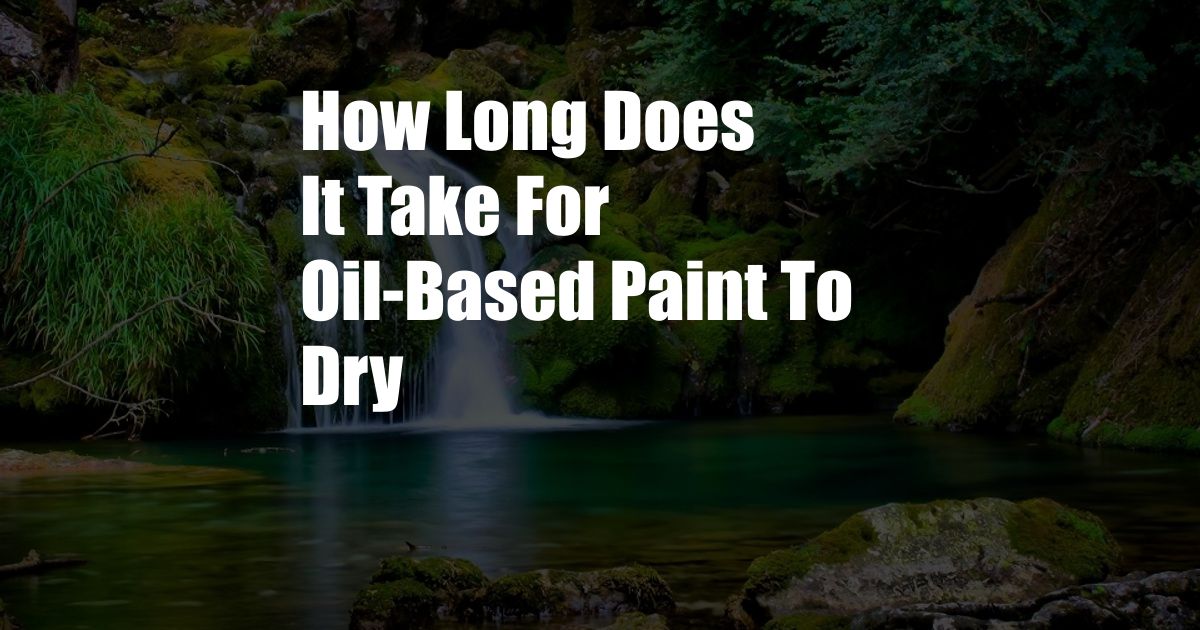
How Long Does It Take Oil-Based Paint to Dry? A Comprehensive Guide
In the world of home improvement projects, painting is often considered one of the most transformative and satisfying tasks. The right paint color can rejuvenate a room, enhance its aesthetic appeal, and even boost your mood. However, before you embark on a painting adventure, it’s crucial to understand the nuances of each paint type, including its drying time. If you’ve opted for oil-based paint, this article will provide a detailed overview of its drying process and offer expert tips to ensure a smooth and successful painting experience.
Oil-based paints have long been a popular choice among painters for their durability, resistance to stains, and beautiful finish. However, they are known to take longer to dry compared to water-based paints. Understanding the drying time is essential to plan your project effectively and avoid any potential inconveniences.
Factors Affecting Drying Time
Several factors can influence the drying time of oil-based paint, including:
- Temperature: Warmer temperatures promote faster evaporation of the solvents, leading to quicker drying.
- Humidity: High humidity can slow down the drying process, as the air contains more moisture that needs to evaporate.
- Air Circulation: Good ventilation allows solvents to escape more efficiently, accelerating the drying time.
- Paint Thickness: Thicker layers of paint take longer to dry as they contain more oil and solvent.
- Paint Composition: Different oil-based paints have varying formulations that may affect their drying characteristics.
Drying Stages of Oil-Based Paint
Oil-based paint goes through three primary drying stages:
- Evaporation: During this initial stage, the solvents in the paint evaporate, leaving behind the pigment and oil.
- Oxidation: The oxygen in the air reacts with the oil, causing it to cure and form a hard film.
- Cross-linking: Over time, the molecules in the oil-based paint form strong bonds, creating a durable and flexible finish.
Typical Drying Times
As a general guideline, oil-based paint takes around 8-12 hours to become touch dry, meaning it’s dry to the touch but may still be soft. The recoat time, or the time you need to wait before applying a second coat, is typically around 24 hours. However, it’s important to note that complete drying and curing can take several weeks or even months, depending on the factors mentioned earlier.
To ensure optimal drying, it’s recommended to follow these tips:
- Apply thin, even coats of paint.
- Allow ample time between coats for proper drying.
- Maintain a temperature of at least 50°F (10°C) during and after painting.
- Provide good ventilation by opening windows and doors or using fans.
- Avoid touching or handling the painted surface until it’s completely dry.
Expert Advice for Faster Drying
If you’re looking for ways to accelerate the drying time of oil-based paint, consider these expert tips:
- Use a paint additive or drying agent specifically designed for oil-based paints.
- Employ heat sources, such as portable heaters or hair dryers, to increase the temperature and promote evaporation (use caution and follow safety guidelines).
- Set up fans to circulate air and remove moisture from the painted area.
- Consider using a dehumidifier to reduce humidity and enhance the drying process.
FAQs
Q: Can I speed up the drying time of oil-based paint?
A: Yes, there are several techniques to accelerate the drying process, such as using drying agents, heat sources, fans, and dehumidifiers.
Q: How long should I wait before applying a second coat of oil-based paint?
A: Allow at least 24 hours between coats to ensure proper drying.
Q: Is it safe to use oil-based paint indoors?
A: While oil-based paints emit fumes during application, they are generally safe to use indoors once they are completely dry and cured. However, proper ventilation is essential during and after painting.
Conclusion
Understanding how long oil-based paint takes to dry is crucial for planning your painting project and achieving a successful outcome. By following the tips and expert advice provided in this guide, you can optimize the drying process and enjoy a beautifully finished surface. Whether you’re a seasoned DIYer or a first-time painter, knowing the intricacies of oil-based paint drying will empower you to tackle your next painting project with confidence and precision.
If you found this article informative, please share it with others who may benefit from it. Your feedback and comments are always welcome, and we appreciate your engagement in this discussion. Happy painting!